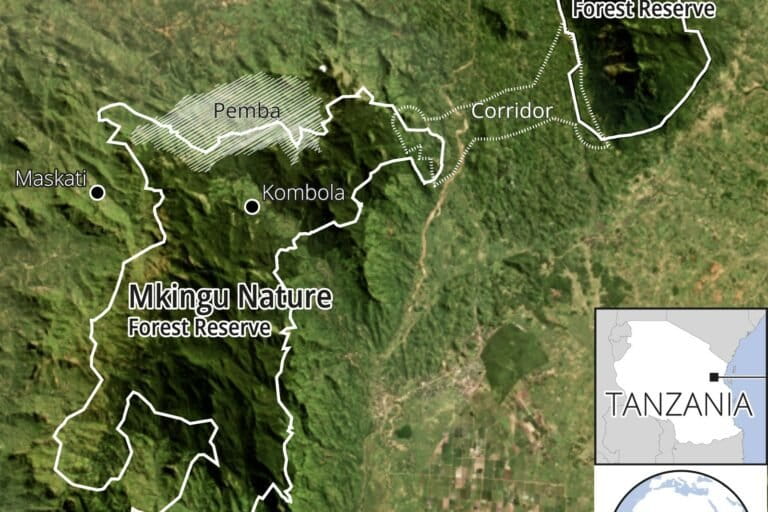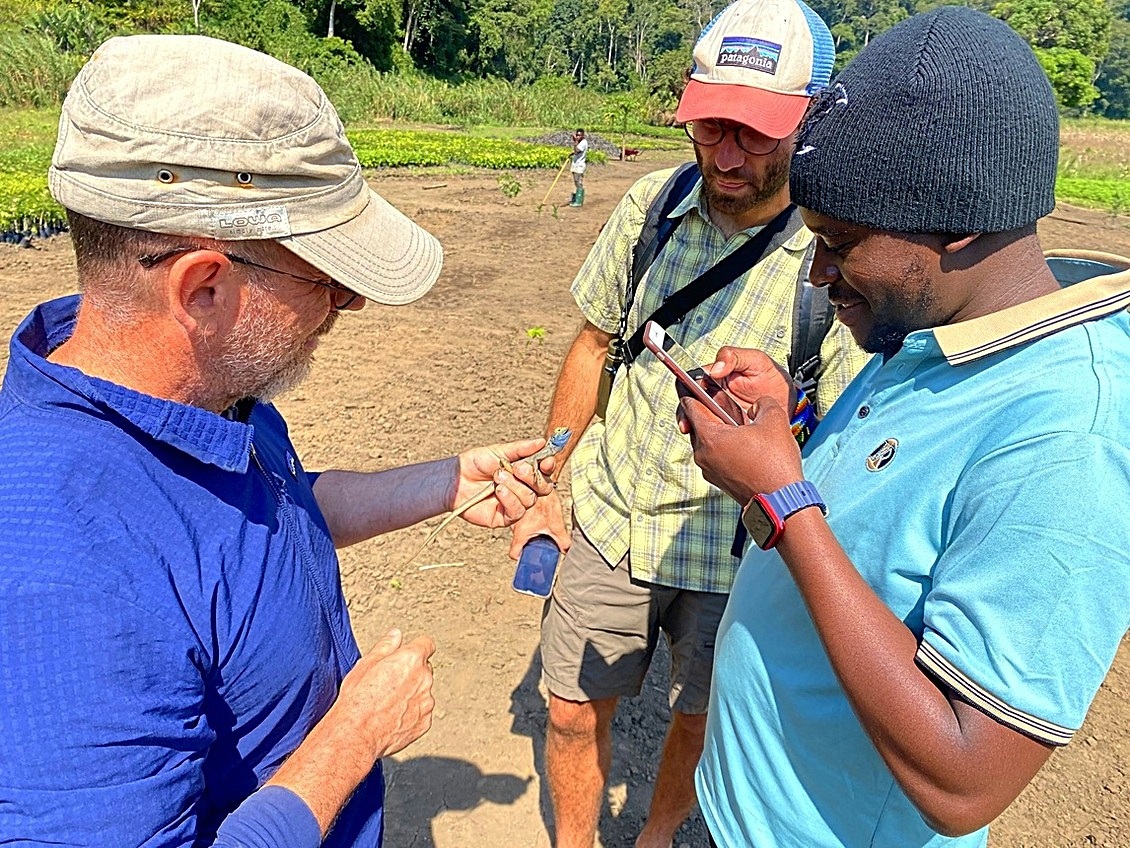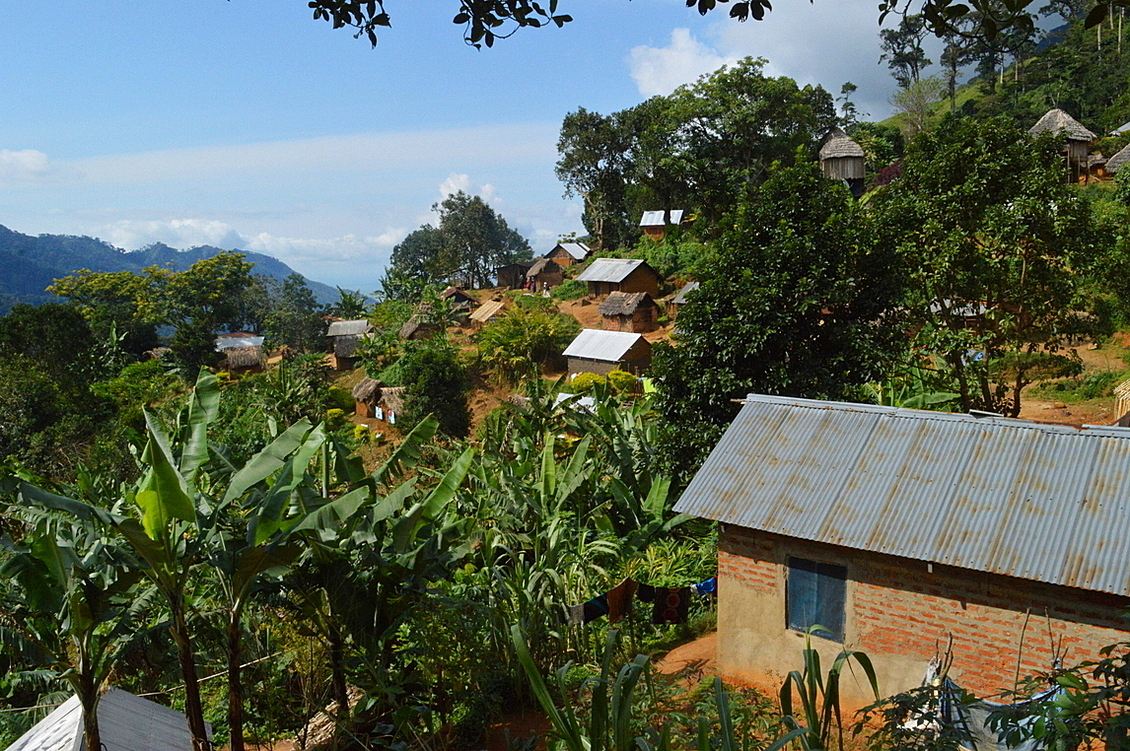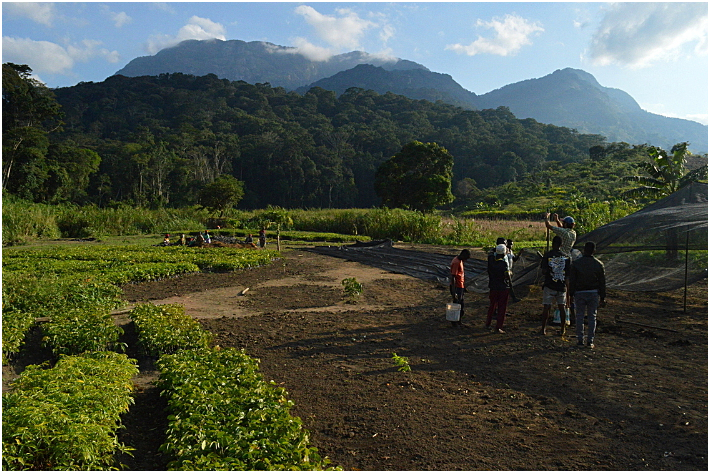- Farmers in eastern Tanzania are regrowing rainforest trees on part of their land.
- The farmers receive payments from the sale of carbon credits to supplement their incomes and to compensate them for loss of land and cash crops.
- So far, close to 270,000 trees have been planted on 200 hectares (494 acres) of farms located on the flanks of the Nguru Mountains.
- Nguru’s forests, home to a wealth of unique animal and plant species, are under increasing pressure from farmers who fell trees to grow crops, including valuable cardamom spice.
DISANGA, Tanzania — Michele Menegon creeps stealthily through short grass before pouncing.
Gently, the scientist holds up his prize: an unnamed species of forest agama. He shows the reptile to two of his colleagues before releasing it back into the grass. The agama, one of many unique animals living in the high-altitude rainforests that cover the flanks and summit of Tanzania’s Nguru Mountains, is new to science. So new that it hasn’t yet been formally described.
“It’s crazy,” Menegon says. “In here there are so many things with no names.”
Menegon, a herpetologist, researcher and conservationist, has personally described dozens of species over the past 30 years: chameleons, geckos, frogs, snakes and toads. Some were found here in the Nguru Mountains, an isolated massif almost permanently capped with clouds and mist that’s one of a dozen similar mountain blocks that form a chain across eastern Tanzania known as the Eastern Arc Mountains. The wealth of animal life in its forests still to be found, let alone described, is one of the reasons he and others are passionate about protecting them.
And they do need protection. Nguru’s 26,000-hectare (64,000-acre) Mkingu Forest Nature Reserve is a reserve in name only. People have grown food for themselves in this region for centuries, but an expanding human population and the increasing demand for additional land for cash crops like cardamom has ramped up the pressure. Tanzania’s population was 26 million in 1990. It now stands at more than 63 million, and farming has become more intensive.
“A century or two ago, it was a combination of farming and hunting and gathering — more of a mixed access to resources,” Menegon says. “Nguru’s surrounding communities have always lived here, yes, but the pressures have increased.”


Cultivating conservation as a livelihood
To try to ease these pressures, the PAMS Foundation, a conservation group that Menegon co-directs from the northern city of Arusha, is piloting a bold new project together with international technical partners and local farmers to regrow the rainforests around Nguru. Tree seeds are collected by teams of mostly local women, and the seedlings raised in a nursery are only planted where there were trees before: on land now owned by farmers. Thirty-year contracts have been signed with 100 farmers to lease out small portions of their farms — anything from half an acre to 4 acres (0.2-1.6 hectares) — for the reforestation project.
“We would like to make sure the areas of replanted forest are big enough to sustain themselves from an ecological point of view; big enough for an animal to cross them and to move from one fragment to another,” Menegon says.
The project aims to scale up operations across the landscape by signing thousands more contracts with farmers, and selling carbon credits (and eventually biodiversity and soil carbon credits) on the voluntary carbon market.
Dutch donor Trees for All recently bought 35,000 carbon credits, half of the project’s current stock, for $16 per credit (the project is not yet registered on the voluntary carbon market, but will be later this year).
Enough has been raised from that first sale to pay the rent, cover running costs, and give some benefit back, Menegon says. He adds the community gets at least 51% of the revenue raised.


“Every time we sell credits, part of that money goes into a trust fund in order to make sure the rent of the land will be paid for 30 years, even if we are not around,” he says, adding that Nguru’s credentials as a carbon store are sound. He points to recent research that ranks Africa’s montane and submontane forests, like those in Nguru, as among the most productive in the world in storing carbon.
The site of the pilot project is the tiny hamlet of Disanga, part of the village of Pemba. The hamlet is perched atop high ridges close to the edge of the forest that grows on Nguru’s northwestern flanks. Here, farmers grow their crops on steep slopes that, a few decades ago, were also covered in rainforest.
More than 270,000 seedlings, comprising 16 rainforest species, were raised in a nursery in Disanga and planted in March and April across 200 hectares (494 acres) of land. Among the trees planted were East African mahogany (Khaya anthotheca); fast-growing wild kapok (Rhodognaphalon schumannianum), and ordeal trees (Erythrophleum suavolens), whose leaf stems are chewed by Udzungwa red colobuses (Piliocolobus gordonorum) until the monkeys collapse intoxicated on the forest floor.
Next year PAMS will raise and plant up to 60 different tree species across 300 hectares (741 acres). The aim is to plant more than 120 species.
Andrea Bianchi, a botanist and tropical forest restoration expert who is part of the project, points to a denuded hillside where farmers have cut the grass around the seedlings to give them space to grow. A number of shrubs have sprung up independently. “Those are saplings of pioneer tree species,” he says. “They will help us a lot.”


Locals beginning to feel the benefits
Nevy Tido, a 38-year-old farmer from Pemba village, says she joined up to supplement her average annual earnings of 300,000 shillings ($123) that she gets from crop farming. Speaking through an interpreter, she tells Mongabay she’s already earned 200,000 shillings ($82) from planting trees on just half an acre of her land.
“I can still continue to cultivate the crops I was cultivating before, and earn more money,” she says.
Joseph Andereas, 29, says he’s received 400,000 shillings ($164) so far for rent and compensation for giving up portions of land on which he used to grow maize, beans and cardamom.
“Some say we are doing a good thing; others that we are foolish,” he says. But he retains ownership of his land, and he believes the critics will eventually join too. “Life will be better than now,” he says.
Like Tido, Andereas does paid, part-time work at the nursery. Such community buy-in is vital to the success of the project, but locals aren’t always easy to convince, says Richard Paul, a graduate of the nearby Sokoine University of Agriculture and the project’s field coordinator. He says women are among the wariest.
“They think in the future their children and grandchildren are not going to have a farm to cultivate their crops for food,” Paul tells Mongabay.
But he envisages a time, maybe 20 years from now, when the farmland surrounding the nursery will be covered with both forests and farms.
Menegon shares that vision, which he predicts will be realized in part by changes in subsistence agriculture over the next 20-30 years. Greater mechanization, better crop varieties and improved farming methods will likely boost yields on smaller pieces of land and, hopefully, ease pressure on forests.
“What I hope is that forested areas will have a much higher value than now, and there will be an understanding that the forest needs to be kept and sustained,” he says. “The idea is to have — in an overall mosaic of land uses — forest that is ecologically functioning.”

Swapping cardamom for carbon credits
Not far from the tree nursery, the Mkingu Forest Nature Reserve’s rainforest still stands tall. A flock of silvery-cheeked hornbills (Bycanistes brevis), trumpeting raucously, glides along its boundary. Below, a field of cardamom shrubs raise their yellowish-green leaves toward the late-afternoon sun. Cardamom, grown to supply the international spice market, is a popular crop in this region. Its cultivation, however, inflicts a heavy toll on biodiversity.
Few know this better than Tanzanian herpetologist John Lyakurwa.
Lyakurwa, a Ph.D. candidate at the University of Dar es Salaam, is studying a genus of forest toads that are found across the Eastern Arc Mountains. His research regularly takes him to the mountain blocks within the chain. Recently he was in Nguru, and what he saw disturbed him.
More and more farmers are clearing the understory of the forest to plant the shade-loving cardamom, he says. These activities are hard to detect via satellite imaging. It takes on-the-ground surveys like his to witness the impact.
“I found some places that were freshly cleared and there were even endemic animals — like pygmy chameleons — still clinging to the cut branches,” he tells Mongabay. “I was struggling to see how these animals were going to survive.”
Stopping the cultivation of cardamom would help, but farmers need alternatives. Earning income from carbon credits could be the answer.
“It’s not only about the carbon credits; there are also the biodiversity credits, which is about monitoring the recovery [of biodiversity] and people getting money by allowing wildlife to recover in their areas,” says Lyakurwa, who is not part of the reforestation project. “I see a lot of potential there.”

Assaying the forest
The increase in biodiversity could eventually produce a lot of credits for the scheme, agrees Menegon. His team is planning to add them to the portfolio on offer to future investors. To do that, the team needs data.
In a forest camp not far from the tree nursery, Adam Tido John, the chief of Disanga who works closely with the conservation team, volunteers to scale a tree to place a bioacoustic recorder in its branches. The device will record the sounds of the forest at intervals over the next few weeks. Later, the recording will be downloaded and run through software to measure species richness. It will provide a baseline for the team to track improvements.
Back in 2004, when Menegon first stayed at the camp, he marveled at the resident flying squirrels (Anomalurus derbianus). These are now scarce. Most mammals have retreated further up the mountain to escape from hunters and other human disturbances. During the day, pedestrians and motorcyclists carrying passengers and goods ply a well-worn path through this part of the forest.
But not all the animals are gone. After dark, Menegon, Bianchi and PAMS Foundation staffer Valentino Tossi walk slowly along a track, flashing their torches into the trees and the undergrowth. Bianchi is the first to find something. It’s a young female veiled chameleon (Trioceros deremensis), one of a dozen species that live in Nguru.
Tanzania is second only to Madagascar in the diversity of its chameleons, with more than 50 species; two-thirds of them live in the Eastern Arc Mountains. In Nguru, however, as in the other mountain blocks within the arc, the pressures of poaching and human encroachment threaten this fragile diversity.

Extending the model
That encroachment is evident next day when Menegon pays a visit to Kombola, a hamlet clinging to a hillside inside the forest reserve. To reach it, one has to climb up a steep path that winds its way through fields of cassava and cardamom. Only a thin belt of forest, a vital connection between two prominent sections of the massif, persists between Kombola and Disanga.
Kombola’s farmers are not yet part of the reforestation project. But perhaps, one day, they will be.
“It’s critical to be ready,” Menegon says, “to step in at the right time.”
Lyakurwa, the Tanzanian researcher, says that, over time, new concepts like the carbon credit scheme piloted at Pemba and Disanga will catch on among neighboring communities.
“It requires a lot of awareness and people want to see progress, and how people are benefiting, and then slowly they will start coming in,” he says. “I believe if locals would be mostly the ones running these kinds of projects, they’ll be even more accepted by broader communities.”
That’s a view that Menegon shares. He says he hopes his organization’s pilot project will provide a template that can be replicated by others, in Tanzania and beyond.


“Something like this should scale up to thousands of projects across Africa, covering hundreds of thousands of square kilometers,” he says.
Back in the forest, Menegon spots a tiny frog on the path. It’s an Eastern Arc endemic, a vermiculated tree frog (Leptopelis vermiculatus), with luminescent lime-green skin scrawled over with fine black markings. Towering 50 meters (164 feet) above the path, the crowns of mtambao trees (Cephalosphaera usambarensis) are alive with the liquid calls of green-headed orioles (Oriolus chlorocephalus).
The frog, the birds, the trees are all reminders of Nguru’s richness.
“If you come back here in 200 years, the farms may look like this,” Menegon tells Mongabay. “If everything goes right.”
Banner image: A woman carries firewood out of the Mkingu Forest Nature Reserve. Image by Ryan Truscott for Mongabay.
Citation:
Cuni-Sanchez, A., Sullivan, M. J., Platts, P. J., Lewis, S. L., Marchant, R., Imani, G., … Zibera, E. (2021). High aboveground carbon stock of African tropical montane forests. Nature, 596(7873), 536-542. doi:10.1038/s41586-021-03728-4


